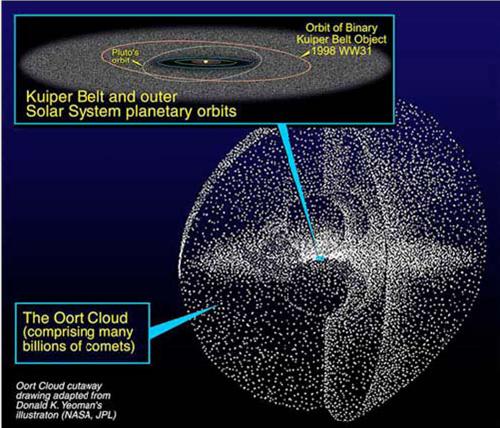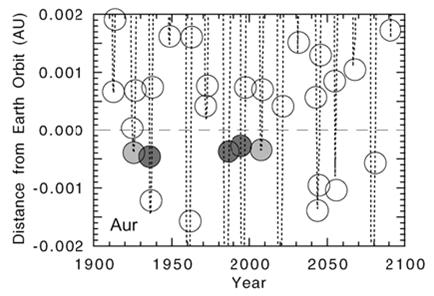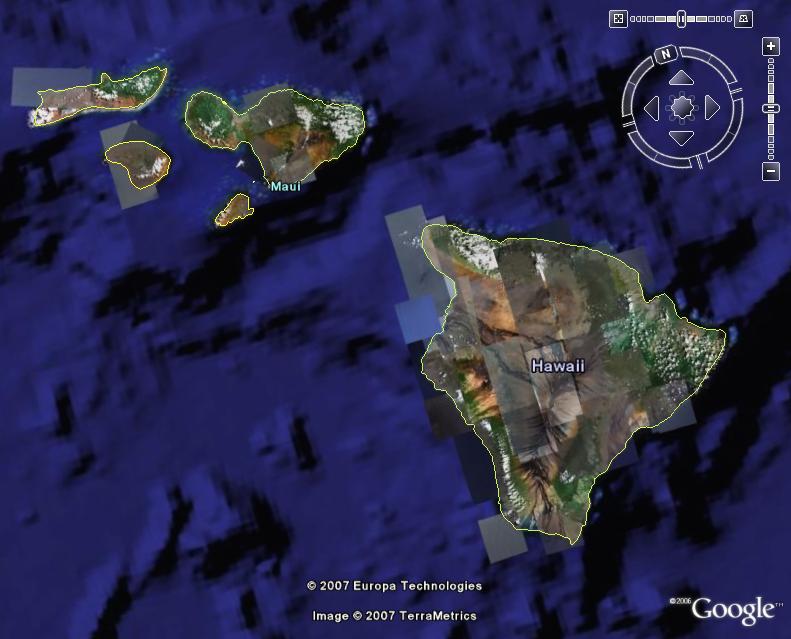Aurigids 2007 (Hawaii) - Meteor
Aurigid Campaign Overview
At the end of August 2007 members of the ESA/RSSD Meteor Research Group (MRG) travelled to the Hawaiian Islands to observe a rare outburst of the Aurigid meteors in the early hours of September 1st. This campaign was carried out in collaboration with research groups from Kobe and Kochi Universities, Japan. The teams observed from two sites: one at the Onizuka Visitors' Center on Hawaii and the other from the Haleakala Observatory site on Maui.
Visual and spectroscopic observations were made of the luminous meteor phenomena assoicated with the disintegration and ablation of dust particles in the Earth's atmosphere. In the case of the Aurigid meteor shower the ablating dust particles are believed to have been produced by Comet Keiss during its second to last perihelion passage, around 82 B.C. In addition to the observations on Hawaii, the MRG's Jason Hatton will take part in an airborne Aurigid Campaign organised by Peter Jenniskens of the SETI Institute.
Background
The content of this page is an amalgamation of reports by Shinsuke Abe (Kobe University, Japan), Apostolos Christou (Armagh Observatory, Northern Ireland), and Jonathan Mc Auliffe (ESA/ESTEC).
The acquisition, reduction and analysis of meteor activity data provides information on meteoroids and their parent bodies, predominantly comets. They are, in a way, a "poor man's mission" to an entire population of objects. Study of all but the most prolific of meteor showers requires the accumulation of observations over several years to build up statistics. Exceptionally, meteor outbursts enable us to collect data on a large numbers of meteor from a particular stream over a short period of time.
In the past 8 years, meteor outburst forecasting, crucial for preparing and coordinating observing campaigns, has taken vast leaps forward, enabling one to predict reliably the time of an outburst to well within an hour and activity levels to a factor of 2. This was exemplified during the recent highly successful international Leonid meteor storm campaigns in 1999 and 2001.
As we enter the 30-year interregnum between successive Leonid storm seasons, interest is moving towards meteor outbursts relating to comets other than the Leonid parent, 55P/Tempel-Tuttle. Observations of such outbursts bring to the fore the real strength of meteor science, that is, the ability to make comparative studies of cometary composition and environment by proxy of their meteor streams.
On September 1st 2007, the Earth is expected to have a unique encounter with a dust trail which was ejected from the long-period comet C/1911 N1 Kiess, that takes about 2000 years to orbit the Sun. In general, comets with periods of more than 200 years are called long-period comets. They are considered members of the Oort cloud, which is a postulated spherical cloud of small bodies, situated about 50 to 50,000 AU from the Sun. This is approximately 1000 times farther from the Sun than the realm of the Trans-Neptunian Objects(TNOs, Edgeworth-Kuiper Belt Objects). Though more than 1200 TNOs have been detected since the first discovery in 1992, no confirmed direct observations of an Oort member have been made up to now. The Oort cloud is thought to be a remnant of the original protoplanetary disc that formed around the Sun approximately 4.6 billion years ago. The most widely-accepted hypothesis for its formation is that the Oort cloud's objects initially formed much closer to the Sun as part of the same process that formed the planets and asteroids, however, gravitational interaction with giants planets such as Jupiter ejected them into extremely elliptical or parabolic orbits.
Figure 1. Trans-Neptunian Objects (TNO's) and the Oort Cloud.
Figure 2. Distance between dust trails and the Earth's orbit. Gray filled circles indicate the observed year of Aurigid meteor outburst. 2007 is expected to have close encounter and no close encounter occurs in the next 70 years (Jeremie Vaubaillon).
Due to gravitational perturbations the orbits of Oort cloud bodies can be altered to bring these bodies into inner solar system. A meteoroid trail is generated by dust ejected from such bodies and such trails often encounter the Earth's atmosphere. The ejected dust ablate in the Earth's atmosphere at hypersonic velocities (~ 67 km/s), and those meteors associated with Comet Kiess are known as the ‘Aurigids'. Comet Kiess was discovered by Carl Kiess (1887-1967), a post-doc at Lick Observatory, California, only days after Lick Observatory was hit by a damaging earthquake (an aftershock of the 1906 earthquake that destroyed San Francisco). In 1935, an outburst of a meteor shower was observed from Potsdam and Prague and only then was comet Kiess identified as the parent body of the meteor shower.
Other outbursts were observed in 1979 and 1980 at west Australia, in 1986 in Hungary, as well as in 1994. According to previous observations, though the duration of the maximum is only about 30 minutes, bright meteors, i.e., larger dust particles, are dominant in this dust trail. Another crossing of the dust trail by the Earth has been predicted for 2007. This crossing was first recognized during an investigation of potential dust trail crossings related to long-period comets by Esko Lyytinen and Peter Jenniskens (Figure 2). They put the peak time at 11:37 UT on September 1. This trail is not crossed again in the next 70 years. We know of no other known long-period comets with similar dust trail crossings. That study followed from an earlier investigation by Jenniskens, where it was discovered that the dust trail of long-period comets are steered into Earth's path only once or twice every 60 years, in a pattern similar to the Sun's reflex motion. That concept was subsequently demonstrated by the successful prediction of the return of the alpha-Monocerotids in 1995.
The Aurigid meteor shower produces annual activity at a maximum rate of 7-9 meteors per hour, over a period from late August until early September, but during an outburst this hourly rate may jump to as many as 400 meteors. The 2007 outburst will not be visible from Europe, Africa and most of the Asian continent, with the exception of the far East. In contrast, the west coast of the United States, Alaska and Hawaii will be prime observing locations.
Aurigid 2007 Observation Campaign
In collaboration with teams from Kobe University, Japan, the Armagh Observatory, Northern Ireland, the SETI Institute, California and DLR, Berlin, the Meteor Research Group of ESA's RSSD took part in coordinated observations of the 2007 Aurigid outburst from the 30th August to the 2nd September. Specifically the MRG carried out double-station observations between 2 of the Hawaiian Islands along with teams from Kobe University, Japan and the Japanese Meteor Society. Both video and still digital recording equipment were used, as well as spectrometers to study the composition of the meteors.
The video meteor records acquired, single and double station, will be used to test models of the physical nature of comet Keiss and its environment, interesting both in itself and as a representative of the long-period comet class. The 1994 visual observations of the Aurigids hinted at low termination heights and absence of the ashes typically associated with the fragmentation of fragile material. This led to the hypothesis, which our data will confirm or refute, that Aurigid meteoroids are unusually cohesive, perhaps originating from the comet's primordial crust shed during its first approach to the Sun 2000 years ago.
In addition, our data will yield a time-referenced activity profile of the outburst (essentially a cross-section of the dust trail). This will be fit to parameter-dependent dynamical models of the stream to tell us how long ago the meteoroids were ejected, at what velocity and how they were affected by non-gravitational forces since ejection.
Specific scientific objectives:
-
Size distribution of dust originated from Oort cloud object.
-
Dispersion of the 1-revolution dust trail, which was ejected approximately 2000 years ago.
-
Spectroscopy of long-period cometary dusts for investigating volatiles such as Na(at 589nm), CN(at 388nm) and OH(at 309nm) as well as refractory inclusions such as Ca and Al.
-
Degree of differential ablation of atoms and molecules can study in the structure of dust grains ejected from an Oort comet.
-
Differences or relationship of elemental abundance between short-period and long-period cometaty dust.
-
Density and strength of dusts from the Oort comet.
The Fun Begins
In order to investigate the scientific questions as cited above, triangulation, imaging and spectroscopy observations between Hawaii (P.I.; Jonathan P. Mc Auliffe, ESA) and Maui island, Haleakala Observatory(P.I.; Shinsuke Abe, Kobe University) were planned for the nights from 30 August and 2 September, 2007. Unfortunately, circumstances beyond our control meant that the logisitics of our observing plan on Big Island had to be changed at the last minute. The Hawaii team did not have the use of the facilities at on Mauna Kea that they had been expected and instead were required to drive 2 hours each way to and from the observing site at the Onizuka visitors centre to their hotel with all their equipment each day! This imposed a serious restriction on the length of time for which the team could observe.
The two teams (MRG and Japanese) arrived on Big Island on the 29th August and met at the Subaru Telescope Hilo office to replan the observations. The Maui team were instructed in the operation of the MRG ICC and SPOSH cameras and the equipment was divided and repacked for that team's hop to Maui the next morning. Due to fatigue and the underestimated time taken to do the aforementioned we did not have time to travel from Hilo to the site on Mauna Kea on the night of the 29th August. One night lost!
On the afternoon of the 30th August the Big Island team drove (2 hours) from Hilo to the Onizuka Visitor's centre (OVC) on Mauna Kea to investigate the site and resources available there. Misunderstandings were the name of the game for this campaign and the team soon learned that there were no facilities available to them for equipment storage that the visitors centre. The equipment would have to be repacked and transport down to Hilo after each night. The power outlets available were those used by the centre's vending machines during the day and were, during the night of the peak, a highly valued and much sought after commodity as amateurs flocked to the visitors centre with their power hungry equipment.
Much to the MRG team's frustration the power converter's they had brought with them were not strong enough to power all 3 of their cameras. And so the night of the 30th August proved for them to be a test of equipment assembly technique. The Japanese team's equipment appeared to have operated happily on its batteries. Having procured the last 2 110 to 220 voltage converters on the Island of Hawaii on the afternoon of the 31st August. The teams once again made the 2 hour drive from Hilo to the OVC. This time, voltage converters in hand, the Big Island team had their equipment up and running by 10:45 UT. This late starting time, given the anticipated peak at 11:17 UT was due to the need to wait for the OVC guests to depart as our equipment was unfortunately position such that departing car headlights would shine right down out baffles. At the more peaceful site of the Haleakala observatory on Maui the team was lucky enough to start recording from around 09:20 UT but had the misfortune of being clouded out for an hour around the predicted peak.
More problems persisted for the MRG team on Hawaii. The initial plan was to have an LCC and ICC (with grating) running parallel observations of the same area of sky, however an inability to resolve more than 2 or 3 stars with the LCC pointing camera - even after some on-site maintenance - meant the scrapping of the MRG spectroscopy attempts and concentration on the double station video observations using an ungrated ICC4. The spectral study will be carried out using the data obtained by the Japanese cameras. The SPOSH camera was operated with a rotating shutter for velocity determination... and upon first inspection appeared to be operating nominally. Later inspection of the data from the Hawaii SPOSH showed a bizarre shifting of every second image with respect to those in between. This offset has been removed during analysis using IDL (our thanks to Jesus Falcon-Barroso of RSSD/ESTEC) and this data is now being visually inspected; saturation due to the full moon means that the regular stacking process for the quick determination of overall counts can not be performed.
For 4 hours surrounding the peak, while setting up the equipment and after it was all running, a separate group from the Japanese meteor society were conducting visual observations from the same location. Although several bright meteors were seen by this group and by the campaign team throughout the night, early indications were that the predicted outburst had not occurred... or at least had not been visible from Hawaii. Early estimates put the ZHR for the peak between 5 and 8. These figures will have to wait for the reduction of the camera date for a revision.
Metrec was used to identify meteors in realtime from the MRG Image intensified cameras on both islands and the results of the peak night are shown here:
Maui Observing Statistics
=================
start of observation : 2007/09/01 09:21:36
end of observation : 2007/09/01 15:16:55
effective observing time : 5 h 55 m 19 s
# active meteor showers : 2
# observed meteor showers : 2
# observed meteors : 44
Sporadics (SPO) : ä=40, í=2.7 mag
Antihelion (ANT) : ä=3, í=2.7 mag
alpha-Aurigids (AUR) : ä=1, í=3.7 mag
Hawaii Observing Statistics
==================
start of observation : 2007/09/01 10:49:24
end of observation : 2007/09/01 14:59:59
effective observing time : 4 h 10 m 35 s
# active meteor showers : 2
# observed meteor showers : 2
# observed meteors : 62
Sporadics (SPO) : ä=46, í=2.1 mag
Antihelion (ANT) : ä=12, í=3.9 mag
alpha-Aurigids (AUR) : ä=4, í=2.5 mag
It is clear that for the length of the observation periods the overall number of observations are low. The full moon will have obscured many of the fainter meteors from detection.
More to come...
Location
Figure 3: The different research groups will be mixed then split between 2 observing sites - one on Hawaii and the other on Maui.
Equipment
-
UV-I.I.-HDTV with UV 30mm F/1.2 and Reflective Grating FOV=40x22 deg. @ Maui
-
VIS-I.I.-HDTV with Fujinon 25mm F/0.85 and Grism FOV=48x27 deg. @ Maui
-
VIS-I.I.-HDTV with Pentax 105mm F/2.4 FOV=19x11 deg. @ Maui
-
VIS-I.I.-HDTV with Pentax 105mm F/2.4 FOV=19x11 deg. @ Hawaii
-
Watec with CBC 8mm F/0.8 FOV=43x33 deg. @ Maui
-
Watec with CBC 8mm F/0.8 FOV=43x33 deg. @ Hawaii
-
SPOSH E2V CCD47-20, back-illuminate 1024 x 1024 pix, 6.6mm F/0.95, FOV ~120 deg. @ Hawaii - With shutter!
-
SPOSH E2V CCD47-20, back-illuminate 1024 x 1024 pix, 6.6mm F/0.95, FOV ~120 deg. @ Maui
-
ICC Image-Intensified Video Camera with Fujinon 25mm F/0.85 @ Maui
-
LCC Image-Intensified Video Camera with Zeiss 50mm F/2.0 @ Hawaii
-
ICC Image-Intensified Video Camera with Blazed-grating @ Hawaii
-
Nikon D40x with Nikkor 50mm F/1.2 and Grism for Meteor & Train Spectrum @ Maui
-
Nikon D70 with Nikkor 50mm F/1.2 for Meteor Train @ Hawaii
-
MINTRON MTV63V1(color) with CBC 3.8mm F/0.8 @ Hawaii
-
Others form AstroArts team; EMCCDs, ICCDs, Digital Cameras etc.
References
- Meteor outbursts from long period comet dust trails Lyytinen, E.; Jenniskens, P. Icarus, Volume 162, Issue 2, p. 443-452.
Page created 05 July 2007.
- Removed a total of (4) style font-weight:bold;
- Removed a total of (1) align=center.
- Removed a total of (16) align=left.








































 Sign in
Sign in
 Science & Technology
Science & Technology


